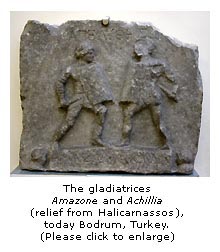Gladiatrices
 The
only depiction of gladiatrices which we have is a relief
from Halicarnassos (today's Bodrum in Turkey) which dates
from approx. the 2nd century AD. Two women in the equipment
of provocatrices are seen who have the arena names
"Amazon" and "Achillia". The helmets lie
on the floor next to the both combatants, because they are
depicted at the end of the fight where they both received
the missio (dismission). That gladiators were dismissed
standing (stantes missio) which counted as a draw because
they fought so well was very rare. Therefore it nearly counted
more than a victory. The
only depiction of gladiatrices which we have is a relief
from Halicarnassos (today's Bodrum in Turkey) which dates
from approx. the 2nd century AD. Two women in the equipment
of provocatrices are seen who have the arena names
"Amazon" and "Achillia". The helmets lie
on the floor next to the both combatants, because they are
depicted at the end of the fight where they both received
the missio (dismission). That gladiators were dismissed
standing (stantes missio) which counted as a draw because
they fought so well was very rare. Therefore it nearly counted
more than a victory.
The Harvard scholar Kathleen Coleman assumes that this relief
stood at the ludus of the two gladiatrices to
honor their extraordinary achievement. If this relief was
part of a whole in which a whole munus was remembered
is not known since no further fragments have been found.
In 1996 the grave of a woman was discovered which was at
the outskirts of the cemetery which is a sign that she was
an outcast from society. Nonetheless she had received a lavish
funeral with a pyre which was errected above a pit. Eight
oil lamps had been put into the pit after the pyre burned
down. One lamp shows a defeated gladiator, three others the
Egyptian death good Anubis who was equated with the Roman
Mercurius. Further there had been found eight tazze
(incense burners) in which were burned pine cones.
The scholar of the Museum of London assume according to these
finds that the woman is a gladiatrix since some artefacts
refer to a gladiatorial context, e.g. the lamp with the picture
of Anubis because Mercurius was the attendant of the fallen
gladiators, as well as a lamp with the picture of a defeated
gladiator. Also the pine has a strong connection to the amphitheater
because in front of the amphitheater of London these trees
were planted to cover the stench of blood. Also gladiators
lived on the edge of society, but might have left enough money
behind so that friends, family or comrades could give them
a worthy funeral.
|
